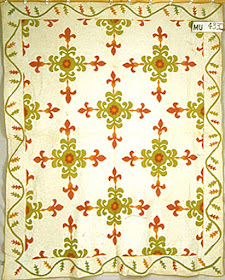Quilt for Lucy Ann Torbet Hill Nicholson
dated 1850, Jennings County, Indiana
Indiana project & the Quilt Index.
Martha Wooton Tanner did us a great favor with her needle. Along the edge of this quilt she stitched a message including the date and pattern name:
"Applique Quilt-Solomon's Crown Made in Jennings Co., Ind for Lucy Ann Torbit 1850. This corner was quilted by Martha Wooton Tanner, aged 94, daughter of Revolutionary Patriot, and wife of Reveolutionary Soldier."
Solomon's Crown,
Four fleur-de-lis flowers with leaves
rotating around a floral center.
What a remarkable message! Not only do we find a period name for an unusual applique design, we see Martha called the technique "applique." (Many people called it laid work at the time.)
A similar pattern is #10.64 in my Encyclopedia of Applique.
Comfort Magazine called it Bleeding Heart in the early 20th century.
The design is a variation on a fleur-de-lis, quite popular with
quilters in the mid-19th century.
Block from a mid-19th-century quilt in the collection of the International Quilt
Study Center & Museum, # 1997.007.0836
Related block later in the century.
Solomon's Crown is a Biblical image from an Old Testament King.
Cyclamen are also called Solomon's Crown.
Martha Wooton Tanner LeMaster herself is easy to trace in online genealogies. Her request for a pension as widow of Revolutionary soldier gives us much information about her long life as does some family history.
Martha's signature on a pension request.
Her name in 1850 was Martha Lemaster,
but she stitched her first married name into the 1850 quilt.
She was born on September 26, 1756, a subject of King George III in Mecklenburg, Virginia Colony and married, according to her recollection, on December 1, 1771 when she was barely 14 years old. Husband Josiah Tanner was a little over 16. In 1779 during the Revolution, they moved to the northern part of South Carolina settling near the French Broad River. In 1780 Josiah went off to fight the Tories, leaving Martha with three girls and two boys ages 7 years to 2 months. He came home to recover from a wound to his right elbow and left to fight again for a year.
Josiah's right arm remained stiff the rest of his life. His daughter Mary recalled that "he had a knife made with a blade eighteen inches long to use while eating, that he might reach his mouth with that arm." (People ate with knives rather than forks.)
Georgetown KY 1813
Ad for the type of store Josiah ran.
Note the proprietor will trade dry goods
for good, marketable Whiskey
or homewoven Linsey.
After peace was declared the Tanners moved to Kentucky in 1796 with their now eleven children. Josiah ran a dry goods and grocery store in Bethlehem in Henry County, northwest of Frankfort. When he died on November 1, 1807 at 53 the youngest of their 13 children were 5 and 10 years old.
After nine years of widowhood Martha married Abraham LeMaster in September, 1826. Many of her children lived in Indiana where she and Abraham settled in Johnson County, south of Indianapolis in 1834. Grandson Mathew J. Tracy (1832 -1917) recalled their farm in "heavy timber and brush wilderness...a half mile west of what is now Whiteland.
"It was my good fortune and great pleasure to often be at her little log cabin home eating corn bread, 'ash cakes' baked between cabbage leaves in the fire place between the dog irons (two stones) on a flat stone covered with embers and fire coals. This with the ever ready milk and butter, was a substantial dinner for the little boy that I was. Little she thought at that time that this little grandson, who she was feeding on ash pone, milk and butter, would in the near future in the Civil War, be fighting her people in her native land, on the historic old river Roanoke in old Virginia." [Mathew served in Company F, Third Indiana Cavalry.]
Places Martha lived in her 96 years
When Martha's father Samuel Wooten died in 1814, he'd left her a fifth of his estate "three or four slaves and the family bible," according to that grandson. "Before leaving Kentucky [for Indiana, nominally a free state], and not finding any use for the slaves, she gave them away as useless property." (!)
Martha would recognize many of the buildings still standing
in Vernon. The whole town is on the National Register of Historic Places.
After Abraham's death in 1837 eighty-one-year-old Martha went to live with youngest daughter Eleanor and husband Thomas McGannon, near Vernon in Johnson County, Indiana. Eleanor had at least eight children, one of whom Mary D. "Polly" McGannon (1815 - 1879) married John Sellers Torbet. The Lucy Ann Torbit (1834-1901) for whom Martha was helping with the quilting on the Solomon's Crown in 1850 was Polly's daughter, Martha's great-granddaughter. Her granddaughter who brought the quilt for documentation reported it was a wedding quilt for Lucy's marriage to John Hill.
We can hope Martha was able to attend many more quilting parties before her death in 1857 at 94. She outlived nearly all of her children. Numerous family members are buried near her in the Freedom Baptist Church Cemetery in North Vernon, Indiana.
The church
Quilt mourning Abby Lemming Forepaugh in 1842
from Stella Rubin's inventory.
Solomon's Crown?
Four fleur-de-lis growing from a floral center.
From Meg Andrews's inventory
See the file on Martha's quilt from the Indiana project & the Quilt Index:
Read Martha's request for a Revolutionary War Soldier's Pension:
Historical Sketches of the Tracy and Tanner Families by Mathew J Tracy, 1915.

















I really enjoy your walk down history lane. Thanks for sharing.
ReplyDeleteI really want to reproduce one of those!!!
ReplyDeleteOh, I loved this post. All the quilts were fantastic, but really enjoyed Martha's story.
ReplyDelete